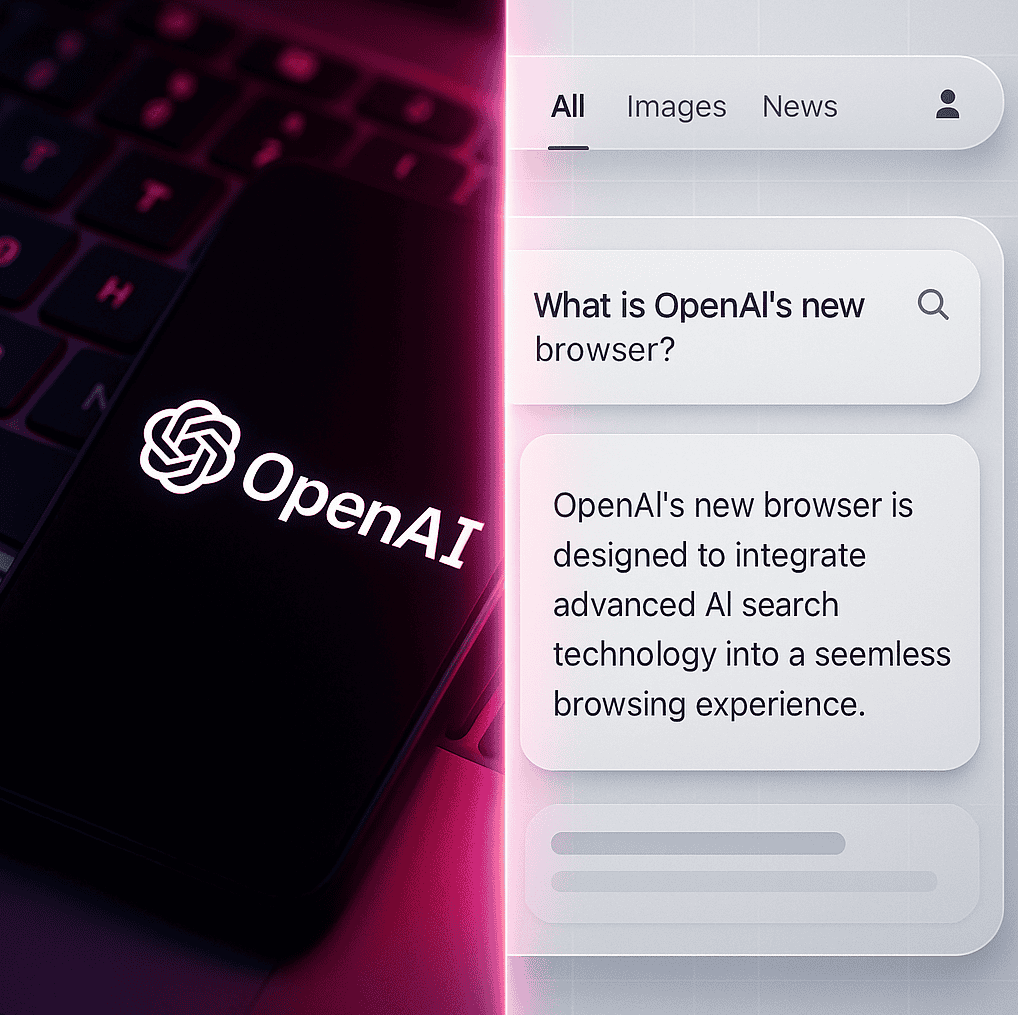Why Businesses Must Adapt to the New AI-First Search Reality
You’ve probably heard the buzz, OpenAI, the creator of ChatGPT, is launching a groundbreaking “OpenAI Browser” that could completely transform how we use the internet. But what’s the big deal, and why should your business care?
In short, this new browser leverages conversational AI to answer questions directly in a chat interface, eliminating the need for users to click through multiple websites. If your business isn’t ready for this shift, you risk losing visibility overnight. Here’s what you need to know and how to adapt.

TL;DR
OpenAI is launching a new browser powered by ChatGPT that delivers instant answers in a conversational interface—bypassing traditional search and website clicks. This shift is already reshaping user behavior, especially among Gen Z, and threatens the visibility of businesses not optimized for AI-driven search. To stay relevant, businesses must audit their AI visibility, adapt content for answer engines, use long-tail and semantic keywords, and maintain strong traditional SEO. ClickIt CMO offers services like AI Visibility Audits and persona development to help businesses navigate this transformation.
About the Author
Shaun Wilson is a Fractional CMO and AI Search Strategy expert with over 15 years of digital marketing experience. He is also a best-selling author who is passionate about helping businesses harness AI-driven search strategies to drive growth. Contact Shaun Here to tap into his expertise or Connect with Shaun Here on LinkedIn to follow his latest insights.
Understanding the OpenAI Browser and AI-Driven Search
The traditional web browsing experience has always involved typing a query into Google, sifting through multiple links, and hopefully finding your answer. OpenAI’s browser changes that by providing direct, conversational answers, instantly.
Rather than clicking links, users will simply ask a question, and ChatGPT will provide a concise, conversational response. Major companies like Google and Microsoft are already moving toward similar solutions, indicating this shift isn’t temporary, it’s the future.
Why This Matters Now: Gen Z and Zero-Click Searches
Gen Z is already leading the charge toward conversational search. Research from Gartner predicts AI chatbots will manage 30% of all searches by 2026, and Bain & Company reports 80% of consumers rely on AI-driven, zero-click answers for at least 40% of their searches. This means businesses that don’t appear in these instant answers risk becoming invisible.
Early studies already show Google’s AI-generated results (SGE) causing dramatic drops in traditional website traffic. Businesses must adapt now to maintain online visibility.
“Gen Z is already leaving Google behind for conversational AI search, they’re craving an experience that feels like 2025, not 2005.” Shaun Wilson, Founder ClickIt, CMO LLC
Practical Steps to Adapt Your Online Visibility Strategy
Here’s your practical roadmap to becoming AI-visible:
Step 1 – Conduct an AI Visibility Audit
First, assess your current AI visibility. Can ChatGPT or Bing’s chatbot find your business? Ask these AI platforms questions about your industry and see how your business appears, or worse, doesn’t.
Consider using professional services, such as the AI Visibility Audit offered by ClickIt CMO, to quickly pinpoint and resolve visibility gaps.
Step 2 – Shift to an AI-Focused Content Strategy
To rank in AI-driven results, your content needs to be clearly structured, concise, and directly answer common queries. Implement FAQ sections, clear headings, and schema markup to help AI tools easily pull answers from your content.
For example, instead of a long blog, structure your content with clear, digestible sections. Provide direct answers early in your content to capture “zero-click” opportunities.
Step 3 – Optimize for Long-Tail and Semantic Keywords
AI users search conversationally. Instead of “coffee shop Denver,” they ask, “Where can I find a cozy coffee shop in Denver to work?”
Identify and incorporate these conversational, long-tail phrases and semantic variations naturally into your content. Tools that highlight “People Also Ask” questions are valuable here.
Step 4 – Adapt Buyer Personas and Brand Tone for Answer Engines
Adjust your buyer personas and tone to align with conversational AI interactions. Consider how your target customers would phrase their questions to an AI.
Ensure your content is conversational yet professional, clear, and consistent. If the AI finds your content clear and authoritative, it’s more likely to cite your business as the source.
Check out ClickIt CMO’s Buyer Persona Development service to refine your personas effectively for this shift.
Step 5 – Keep Your Traditional SEO Strong
Traditional SEO practices remain crucial. Maintain site speed, mobile optimization, backlinks, and valuable content, these traditional SEO factors boost your credibility, enhancing AI’s trust in your content.
My Final Thoughts
The OpenAI Browser isn’t just another tech gimmick, it’s a clear sign of an evolving search landscape. By proactively shifting to an AI-first visibility strategy, your business can not only survive but thrive in this new era.
Ready to get ahead of the AI revolution? Contact ClickIt CMO today to schedule your personalized AI Visibility Audit!
Frequently Asked Questions About AI Search Visibility
What is the OpenAI Browser?
The OpenAI Browser is an AI-powered web browser by OpenAI, providing instant conversational answers directly within a chat interface, replacing traditional search engine clicks.
Why should my business care about AI-driven search?
AI-driven search significantly impacts your visibility. Users receive direct answers, so businesses must adapt content strategies to be featured in these AI-driven results.
What is a zero-click search?
Zero-click searches occur when users find answers directly from search engines or AI chatbots without clicking through to websites.
How can I quickly improve my AI visibility?
Perform an AI visibility audit, optimize your content structure, and incorporate semantic keywords and FAQ sections to improve your presence in AI-generated results.
